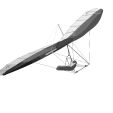Your normal, everyday, flight simulator is not going to let you Hang Glide. Just that simple. With the exception of Freeflight Experience, you will need software running outside your simulator to make it simulate Hang Gliding.
You will need to force it to allow you to do this type of aviation. Hang gliders only resemble other aircraft in that they use the laws of aerodynamics once in the air. And even that is not truly represented in their flight modelling.
Just the basics
These are just the basic functions that the simulators can not do without help. And this is assuming that they have a working, flyable, glider model compatible with the simulator. We will just assume that for now.
Sites
You need a place to launch from. You need a place to land. Hang gliding sites are not known since they are not airports. Navigating to some known place needed to be simplified and crowd sourced as there are literally thousands of known sites and millions of potential ones. We should be able to find and fly from any of them with ease. Some are simple, like just off the side of a road. Others are complex like Lookout mountain flight park that has aerotowing, grass foot launching and a huge wooden ramp. Each is very unique. Most airports are like every other airport.
Ground Handling
You need to move your glider about a site. With an airplane, this would just be taxiing around an airport on the taxiways. Hang glider sites are in all sorts of shapes and sizes and configurations. Simulators want aircraft to have wheels, brakes, motors, and rudders to control aircraft on the ground. Hang Gliders have people. The more real the scenery, the more real the ground handling must be.
Ground handling is a combination of Glider model, Animations, Simulator, and wind modeling.
Wind/Weather
Hang gliding IS nothing but wind and weather! Without realistic wind and weather, you are not hang gliding you are just calculating aerodynamic forces and showing some scenery. The experience of hang gliding is the understanding of the invisible world of air around you. It is about learning thru feel and observation that allows a human to fly at will in an invisible world of air. The simulator we started with had zero wind and weather. Ok it had some, but nothing about it was dynamic. That had to change.
Wind and weather can only be done by the simulator itself. Outside software can control it.
Ridge and Thermal lift
The physical result of wind and weather is ridge lift and thermal lift. It must be determined by and interacted with the landscape itself. This is how hang gliders fly and to do it realistically, you need to be able to predict lift based on terrain, clouds and weather changes. It is what makes you a good hang glider pilot! So simulators that do not do this correctly (none of them do) cannot simulate hang gliding. Again we were forced into improvising some software add-ons to make this happen. While it works (somewhat), it only works for the worst simulator!. MSFS 2020 promises a weather upgrade in late 2022 to address this. Can we use it? I do not yet know. Freeflight experience has these features and we are in the process of exploring them!
Lift physics must be rendered by the simulator. Thermal location and even ridge lift, can be injected by outside software but this should never be necessary if the wind/weather models are real.
Launching/Landing
Launching a hang glider is not like any other aircraft in existence. To be properly simulated, one must choose where they are going to launch (a skill). Then move to that launch by picking up and setting down the glider as it is moved (a skill). Then the actual timing of a launch using wind and other observations (a skill). This sometimes requires that the glider is picked up and set down multiple times as it is physically taxing to pick the glider up and hold it in the launch position. Then there is the run that requires that the glider pitch is set correctly (a skill) relative to the slope of the hill, terrain type and the wind.
Landing is generally the same as other aircraft. You must set up an approach and judge your glide and distances. Obstacle avoidance can be a big factor as well as considerations for rotors and other anomalies with wind flow. Glide slope manipulation can be done by going into an upright position. This involves moving your hands and changing body position. You must also prepare for a flare by even more hand movement and then the actual flair. No aircraft flares like a hang glider! It can be brought to an absolute stop with a big flair or you could climb if done too early or bonk in if too late. But in all cases, the goal is to slow to walking speed just as your feet touch the ground. A hard learned skill indeed.
Once back on the ground, ground handling rules should be reapplied.
No simulator we have seen does any of this. This will be a feature of the glider modelling and we will see where that goes.
Logbook
You really want your flights recorded so you have some history. Your brain will just forget the majority of your flying. This should be an automatic feature of any simulator. To do this, it must know where you are, when you launched and when you landed and where. Most simulators do this by using airports and therefor cannot tell that the hang glider model in them is actually flying, let alone record it.
Whatever software controls the launch and landing sequences should be in charge of the flight log.
